Biologists who wish that the public better understood and appreciated their work have a valuable chance to learn why general comprehension of their science is fragmented and, most would say, poor. The Proceedings of the National Academy of Sciences (PNAS; www.pnas.org) this month publishes highly relevant articles on the science of science communication, based on the Arthur M. Sackler Colloquium of that name that took place in Washington, DC, in May 2012 ( www.nasonline.org/programs/sackler-colloquia/completed_cottoquia/science-communication.html). As scientists, biologists ought to take scientific findings seriously, and many of the social science findings reported are counterintuitive and important.
A draft overview article by Dietram A. Scheufele of the University of Wisconsin—Madison hits some of the key points. Opportunities for the public to learn about science are changing rapidly (think about the decline of science coverage in newspapers and of traditional media in general). Social science shows that attitudes toward science correlate poorly or not at all with scientific literacy. Rather, trust is the key to receptivity: Individuals' attitudes are much more strongly influenced by their ideology and religiosity than by their level of knowledge.
All the more worrying, then, that news outlets are becoming more partisan and increasingly tend to polarize attitudes toward institutions. Yet, simply providing more information about science in public settings, in an attempt to “sell” it, is unlikely to increase buy in—a fact that social scientists have long known but that many others have been reluctant to accept. Such naive efforts risk exacerbating the gaps in understanding between those already well disposed to science and those less so.
Scientists who want to broaden public esteem for their subject must also engage the populace in debates about long-term attitudes and values, while recognizing the crucial importance of cultivating good impressions and of good framing. Researchers serve their profession well when they present information in ways that are accessible to nonexpert viewers, listeners, or readers. Although some scientists are inclined to avoid debates about values, these are unavoidably present at the cutting edge, perhaps especially at the cutting edges of biology and nanotechnology.
The PNAS symposium issue serves as a backdrop to the Roundtable on Public Interfaces of the Life Sciences taking place under the auspices of the National Academy of Sciences. Participants in the roundtable, chaired by May R. Berenbaum (a former president of AIBS), of the University of Illinois at Champaign—Urbana, and by Scheufele, spent several hours in June hearing research updates and learning how scientific organizations are endeavoring to establish better interfaces. Studies and workshops may follow. Many organizations, not least AIBS, are putting effort into improving the interfaces between their science and the wider world (see, for example, www.aibs.org/public-programs).We encourage scientists to take advantage of these and other opportunities. Funding for all such efforts is tight, however, and seems likely to get worse before it gets better. Extending the influence of science will, for the foreseeable future, rely heavily on the willingness of individual researchers to improve how they communicate their work's value.





